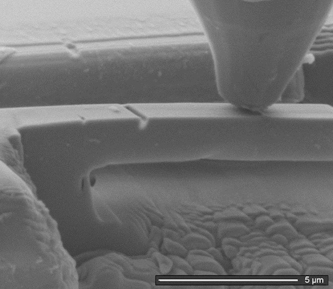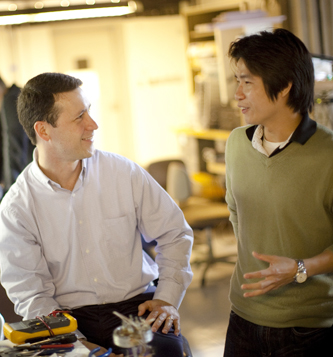Connecting fractures to impurities
Richard P. Vinci and his group are testing the toughness of very small amounts of metal and ceramics and finding some surprising insights.
Their work in damage-resistant transparent ceramics could lead to improved windows for spacecraft. And designers of automobiles and structures can benefit from learning why certain impurities cause brittleness and fracture at the grain boundaries of some metals and ceramics.
Just a few parts per million of an impurity, says Vinci, professor of materials science and engineering, can weaken a steel beam. “Exactly why it happens continues to elude us. Figuring this out is what our work is focused on.”
Vinci’s group is studying spinel, a class of ceramics with promising military and aerospace applications, such as blast-proof windows. Spinel windows can be affordably made by adding lithium fluoride during manufacturing. But the compound migrates to the grain boundaries and weakens the spinel, obligating companies to use a more expensive fabrication process.
By conducting atomic-scale studies, Vinci’s group hopes to learn why lithium fluoride causes brittleness. They are also experimenting with ytterbium, which migrates to grain boundaries but strengthens the spinel. They are using Lehigh’s scanning and transmission electron microscopy (SEM and TEM) facilities to determine why this strengthening occurs.
The group also studies copper tainted with bismuth, an impurity that occurs in copper ore and can also appear when metals are mixed during recycling. In tests conducted on single grain boundaries with an SEM Picoindenter, the researchers have found that only certain boundaries are problems. They are attempting to pinpoint the culprits.
The Picoindenter, developed by Hysitron, a manufacturer of nanomechanical testing instruments, applies tiny forces to an object inside an SEM while measuring the force and the amount of deformation it causes. Hysitron chose Lehigh as the beta site to test the Picoindenter, which is the first device of its kind.
The project is supported by NSF and the Office of Naval Research. Collaborators include Profs. Martin Harmer and Masashi Watanabe and research scientist Animesh Kundu.
Posted on:



